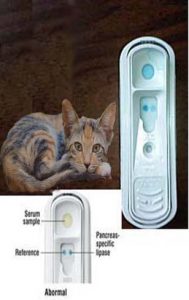Ron Hines DVM PhD
fPL aka PLI, Feline Pancreas-specific Lipase Test, Pancreatic Lipase Immunoreactivity
The SNAP® fPL™ Test (by Idexx)
This is not your pet’s serum lipase level
This test was designed specifically for cats. A similar one, the cPL test is designed for dogs.
Veterinarians have tracked total blood lipase levels in cats for a long time. They knew that the level of that digestive enzyme, necessary to absorb certain fats (triglycerides), often went up in cats when they had pancreatitis. But lipase-like compounds are not only produced in your pet’s pancreas, your pet’s liver, adrenal glands and blood vessels also produce some. So, a high total blood lipase level might truly indicate pancreatitis; but it might also indicate intestinal or kidney disease. The fPL (for cats) and the cPL (for dogs) are thought to be better at zeroing in on pancreatic problems. The test is often performed to try to explain the cause of sudden bouts of vomiting, depression and abdominal pain and lack of appetite in your cat.
The test is not perfect, but it gives accurate results about 80% of the time.
A recent study found that severe trauma (high-rise syndrome = falling off of balconies or upper story windows) can also cause fPL levels to be abnormally high. (read here)
Complimentary Tests:
CBC /WBC and blood chemistry profile including PCV, TP, glucose and electrolytes, urinalysis, x-ray/ultrasound, FIV and FLV test, T4 if the cat over 6 years old, cobalamin and folate levels, fecal examination
DxMe
You are on the Vetspace animal health website
